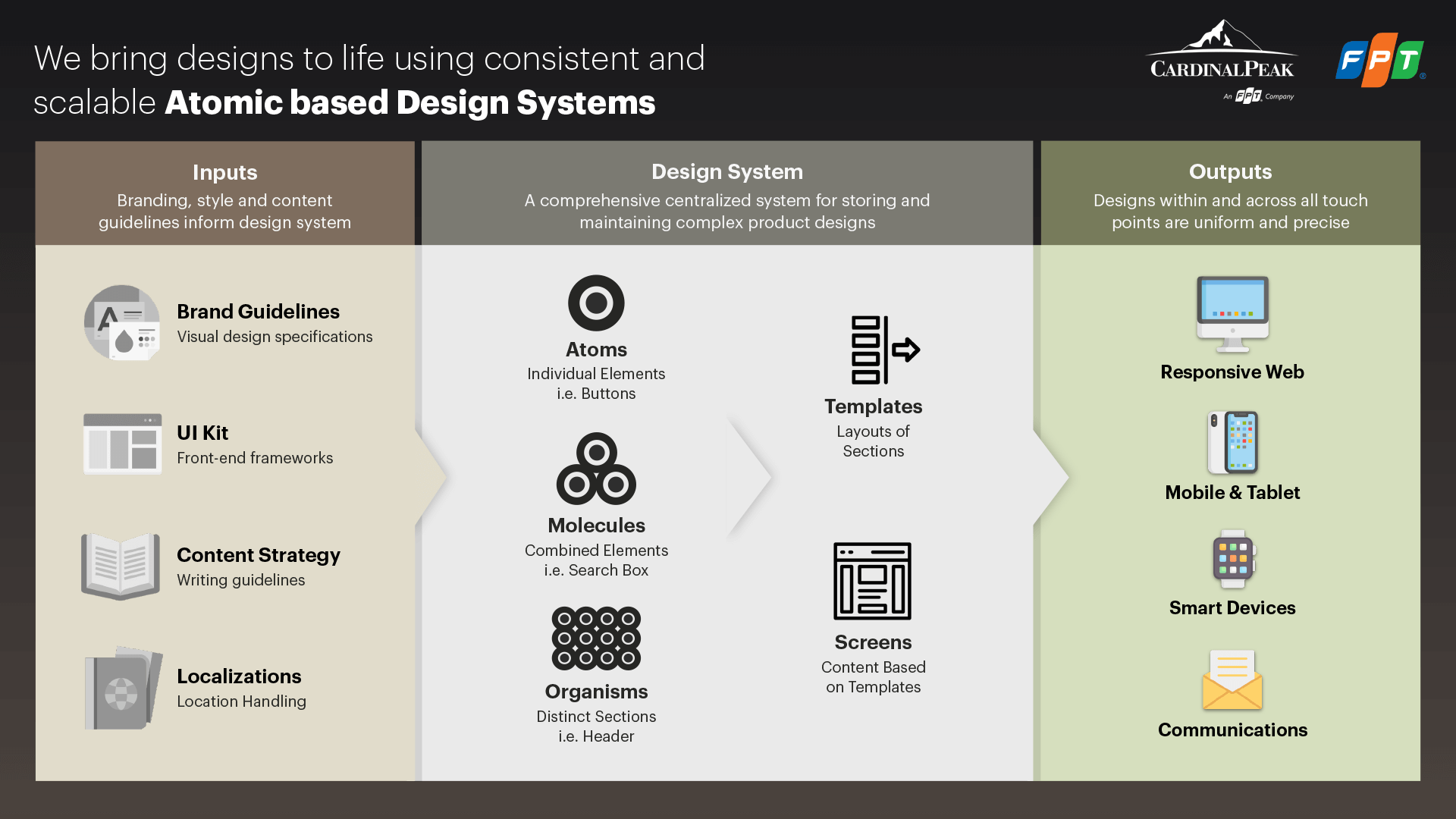In the world of digital product development, speed and consistency are king. As you scale your product, adding new features and expanding across platforms, maintaining a cohesive and high-quality user interface can become a significant challenge. The solution? A robust Design System.
Many teams mistake a design system for a simple style guide—a document outlining colors and fonts. But a true design system is much more. It’s a single source of truth, a comprehensive library of reusable, pre-built components and clear guidelines that align design and engineering. At Cardinal Peak, we’ve seen firsthand how investing in our user interface design services to create a design system isn’t a cost center; it’s a powerful engine for acceleration. As the figure below illustrates, a mature design system has clear inputs, a structured methodology, and consistent outputs.
Anatomy of a Design System: Inputs, Process, and Outputs

Contents
Eliminates Repetitive Design and Development Work
Without a design system, your team is constantly reinventing the wheel. A designer creates a new button, and a developer has to code it from scratch. This process is repeated for every new feature, wasting countless hours and introducing inconsistencies.
As shown in the figure, a design system breaks components down into their smallest parts (Atoms) and combines them into larger, reusable structures (Molecules and Organisms). This provides a library of pre-built components that empowers both designers and developers.
- For Designers: They can quickly assemble new, on-brand interfaces without having to design every element from the ground up.
- For Developers: They can pull pre-coded, pre-tested components, confident that they meet both design and accessibility standards.
This approach transforms your UI UX Design agency partnership from a series of one-off tasks into the creation of a scalable toolkit, drastically reducing the time spent on mundane, repetitive work.
Ensures Brand Consistency and a Cohesive UX
As your product grows, so does the risk of a fragmented user experience. Different teams working on different features can lead to slight variations in UI elements, creating a disjointed and unprofessional feel for the user.
A design system is the ultimate guardian of brand consistency, ensuring the entire user experience remains seamless and unified. This creates the consistent Outputs shown in the diagram—from responsive web designs to mobile apps and smart devices—ensuring your brand feels cohesive across all touchpoints.
Bridges the Gap Between Design and Engineering
The handoff between design and development is a notorious source of friction and misinterpretation. The design system, as illustrated from Inputs like brand guidelines to final Outputs, acts as a common language and creates a seamless bridge between the two disciplines.
The Cardinal Peak approach to UI engineering services is built on this principle—we see the design system not as a separate deliverable but as a core pillar of the entire development process. The design system isn’t just a Figma file; it’s a living, breathing part of the development process. Components in the design library often map directly to components in the code repository. This tight integration means there is less ambiguity, a faster development cycle, and a final product that perfectly matches the design intent. When your user interface consulting is this closely tied to implementation, you eliminate the “lost in translation” errors that can derail a project.
Learn more in our blog posts, An Engineer’s Guide to UI: Essential Design Principles for IoT and Embedded Systems and From Figma to Front-End: Acing the Designer-Developer Handoff.
Conclusion: Build Faster and Better
A design system is one of the most powerful investments you can make in your product’s future. It’s a strategic tool that enables you to build better products, faster, and with greater consistency. By moving beyond a simple style guide and embracing a system-level approach, you empower your teams to focus on what truly matters: delivering innovative features and creating value for your users.
Ready to build faster and better with a design system? Schedule a consultation with our UI engineering services team to discuss your needs. If you’re not sure where to start, our UX audit services can provide a clear roadmap by identifying existing inconsistencies and opportunities for improvement.
